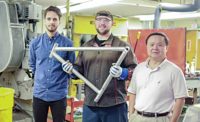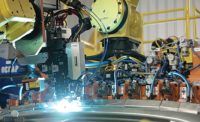AUBURN HILLS, MI—Despite the recent focus on electric power trains, automakers aren’t ready to throw in the towel on the good old internal combustion engine. Engineers are studying how to deliver more efficiency out of smaller sources, such as turbocharged 2.0-liter four-cylinder engines, without sacrificing performance.
Getting there means using more pressure (boost) and higher compression ratios. However, doing that generates more heat in the cylinder head, which sees some of the highest temperatures in an internal combustion engine.
A major challenge is overcoming the strength and thermal limits of the aluminum alloys traditionally used for cylinder heads. Those alloys, known as 319 and 356 grades, begin to severely weaken above 392 F.
Engineers at FCA and Oak Ridge National Laboratory think they have a solution. They recently developed a new aluminum alloy that stays strong up to 572 F.
In addition to staying strong at higher temperatures, the new alloy can be cast and machined using existing technologies and costs only 7 percent more than today’s materials.
The new alloy, known as 16HT or ACMZ, may enable engineers to narrow the “bridge” areas in the cylinder head—the areas of metal between the valves, the spark plug and the direct fuel injector. Narrowing the bridges frees up room for larger valves or even a second spark plug, giving engineers the flexibility to tailor an engine for the desired balance of performance and efficiency.
ACMZ has one key difference from today’s automotive aluminum alloys—it does not use silicon as the strengthening component. Instead, ACMZ uses copper.
“Aluminum alloys with copper are not new,” says Gregg Black, senior manager of advanced power train engineering at FCA. “However, they are expensive, produced in low volumes and haven’t been used in the auto industry due to a tendency for the part to develop small cracks during solidification after casting, an issue known as hot tear.
“When we focused on copper, other people in the industry almost laughed us off, saying we’d never be able to cast that,” Black says. “We knew there was competition, including other teams working at Oak Ridge National Labs, but we outperformed everyone on this.”
It will still be a few years before ACMZ appears in a production engine. But, more than 100 cylinder heads have already been cast with the alloy, using a current production design. Some prototypes have also undergone several hundred hours of dynamometer testing.
Castings made with ACMZ have been machined on the same equipment used for current production cylinder heads to prove that the new alloy is compatible with today’s manufacturing technology. According to Black, the only likely change in the manufacturing process for ACMZ involves refining the heat-treatment ovens used after the part is cast.



